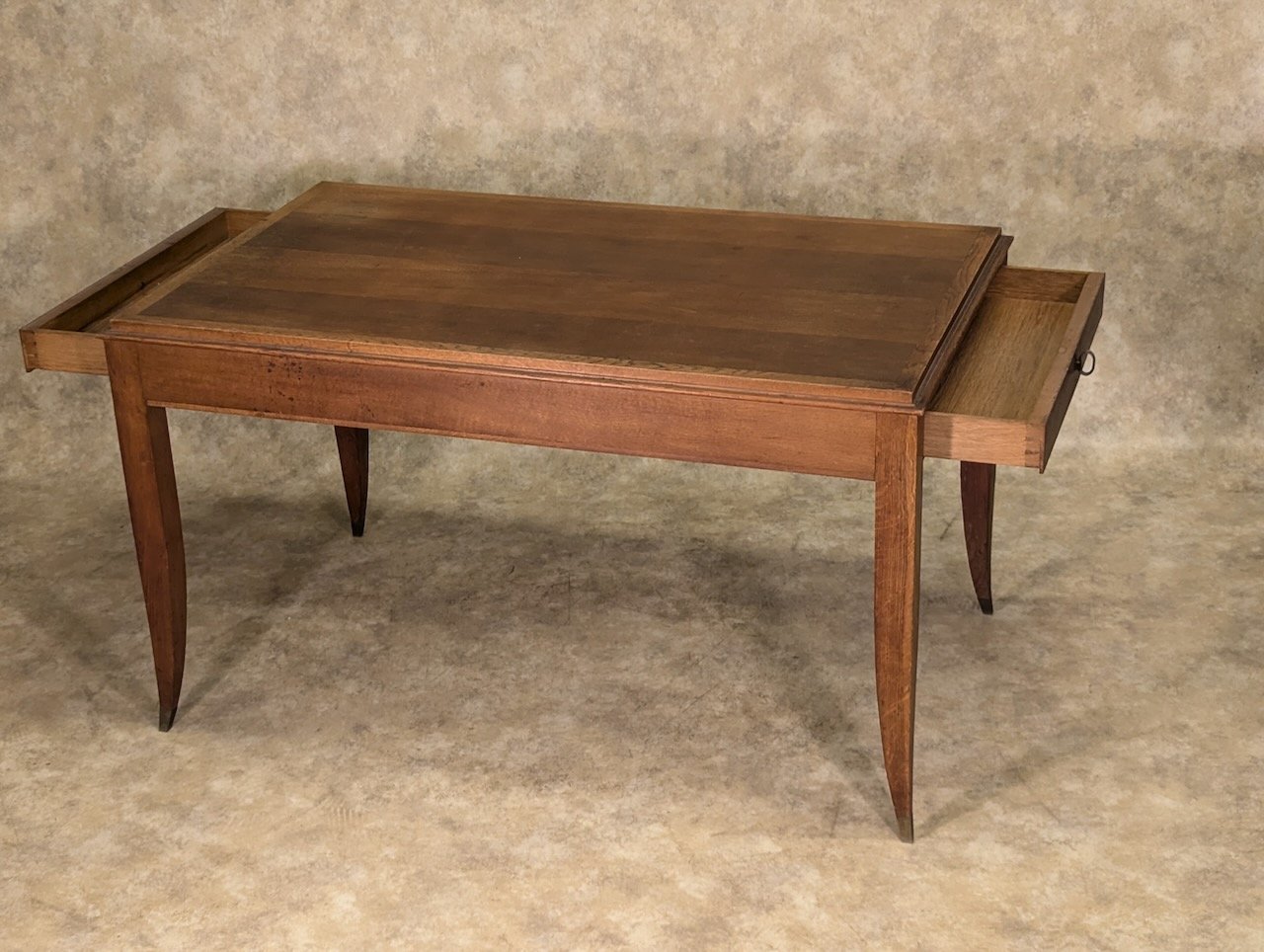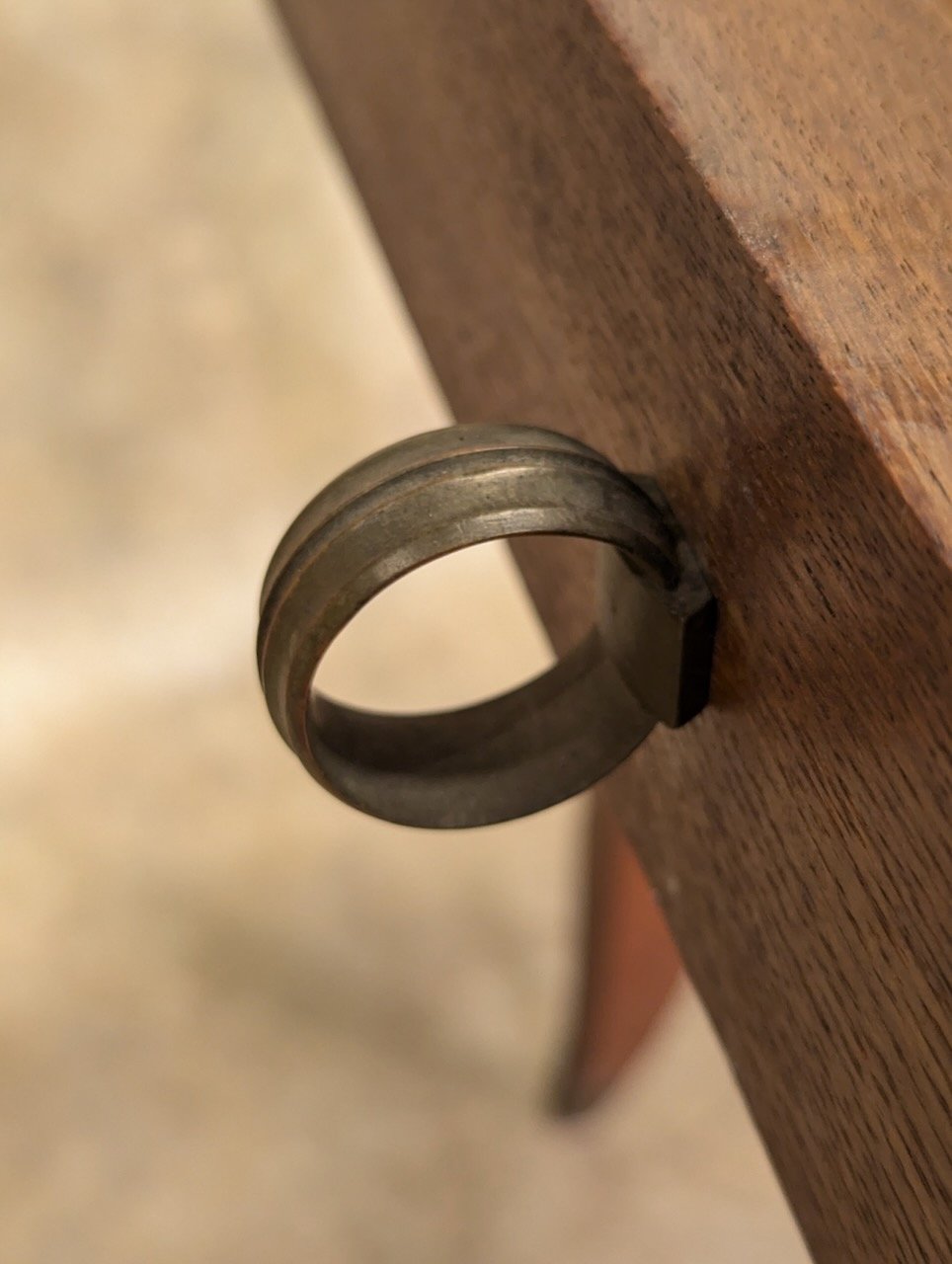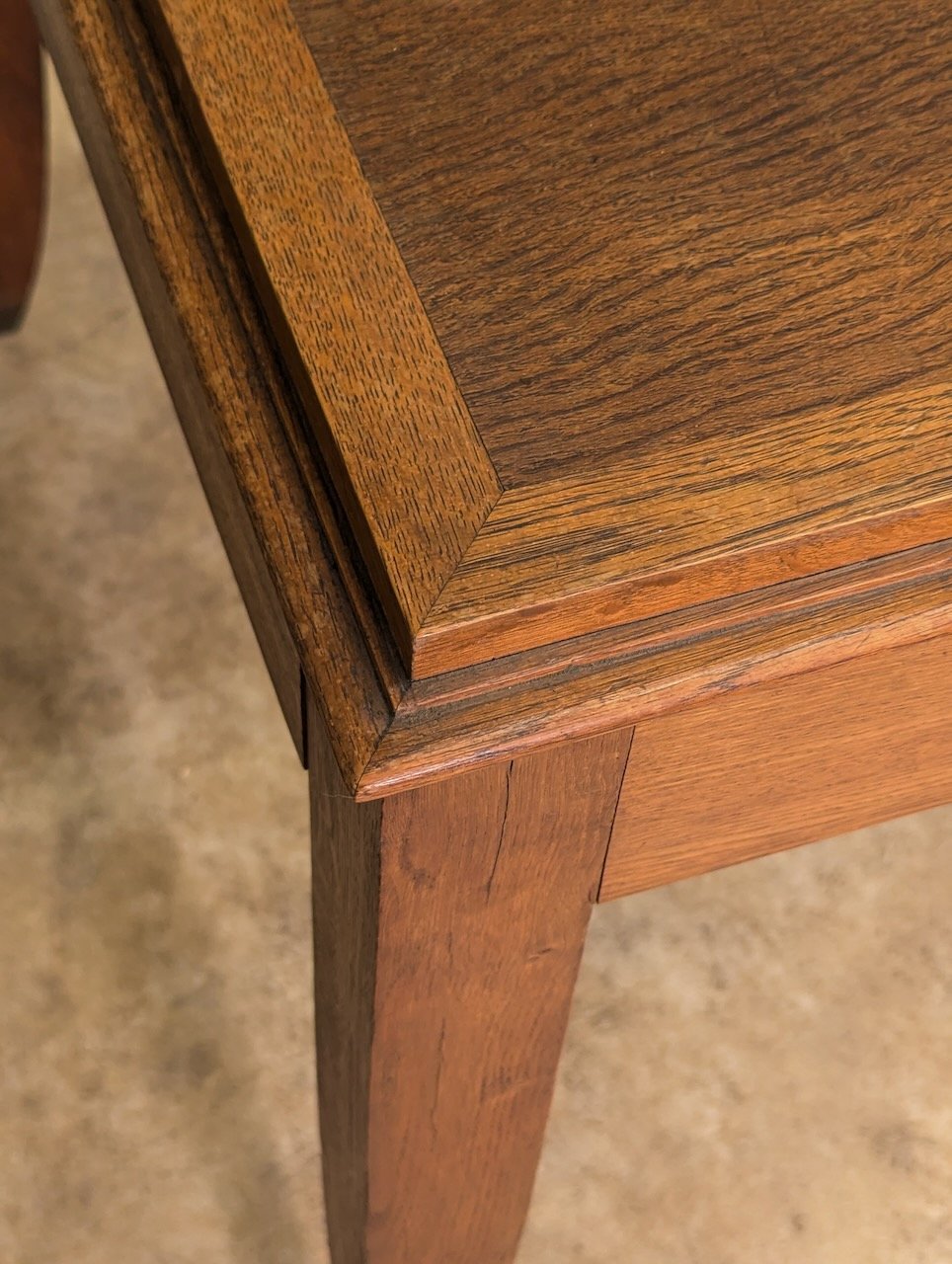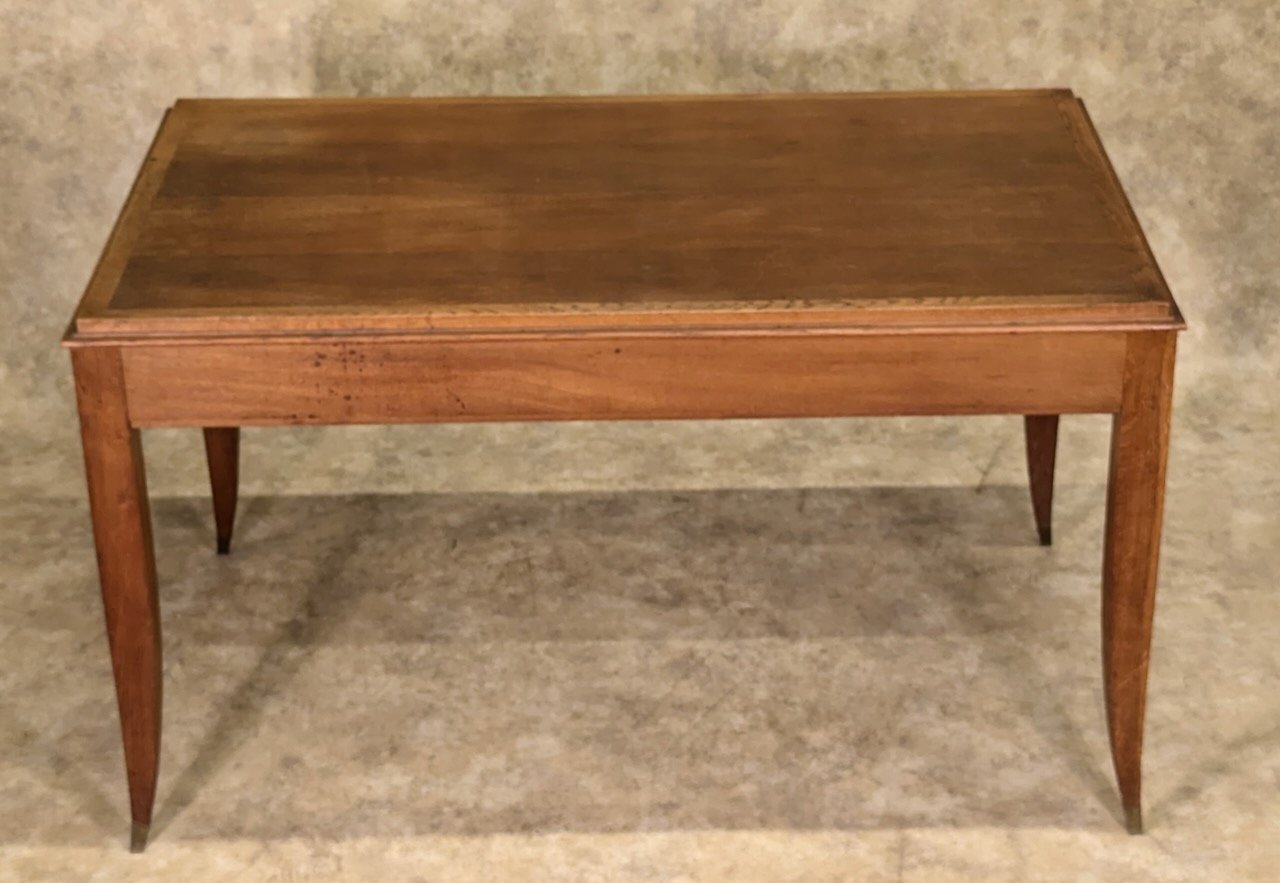Lucien Rollin Art Deco desk #1895
French Modernist Art Deco desk by Lucien Rollin, circa 1935, in oak with bronze drawer pulls. This desk is part of an office suite by Rollin (please see #1135 for the entire suite) and is available with or without its matching armless chair. The desk is 51” wide x 31.5” deep x 29.5” high and the open height beneath the apron is 23.5”.
Lucien Rollin studied at the Ecole Boulle in Paris. Following his studies Rollin worked in the studio of the Master of Art Deco, Jacques-Emile Ruhlmann. Later he returned to the Ecole Boulle while he worked for the architect Michel Roux-Spitz.
Rollin participated in Ruhlmann’s Hotel du Collectionneur pavilion at the 1925 Exposition Internationales des Arts Decoratifs et Industriels Modernes in Paris (now called the 1925 Expo – the exhibition which later launched the term “Art Deco”).
In 1928 Rollin set up his own studio and was influenced by a diversity of sources including Ruhlmann, Frank Lloyd Wright, classical Greek and Louis XVI styles. He became a prolific designer of Art Moderne furniture and his work was included in the annual salons of Societe des Artistes Decorateurs beginning in 1928. After 1928 his work was respected to the degree that his future entries were exempt from jury judging and he became a permanent member of the Societe.
Rollin designed staterooms for the grand French oceanliner, Normandie in 1935; and received government commissions from the city of Aubusson, and from the renowned Mobilier National for the Elysee Palace (the French “White House”) and for the French embassy in Brussels. He designed several rooms for the French pavilion at the 1939-40 New York World’s Fair: The World of Tomorrow.
Also in the USA, he showed his work at the Marshall Fields Gallery in Chicago and redesigned the interior and furniture of Bullock’s Wilshire Building in Los Angeles, CA.
His later career was devoted to architecture which he pursued into the 1980s.
French Modernist Art Deco desk by Lucien Rollin, circa 1935, in oak with bronze drawer pulls. This desk is part of an office suite by Rollin (please see #1135 for the entire suite) and is available with or without its matching armless chair. The desk is 51” wide x 31.5” deep x 29.5” high and the open height beneath the apron is 23.5”.
Lucien Rollin studied at the Ecole Boulle in Paris. Following his studies Rollin worked in the studio of the Master of Art Deco, Jacques-Emile Ruhlmann. Later he returned to the Ecole Boulle while he worked for the architect Michel Roux-Spitz.
Rollin participated in Ruhlmann’s Hotel du Collectionneur pavilion at the 1925 Exposition Internationales des Arts Decoratifs et Industriels Modernes in Paris (now called the 1925 Expo – the exhibition which later launched the term “Art Deco”).
In 1928 Rollin set up his own studio and was influenced by a diversity of sources including Ruhlmann, Frank Lloyd Wright, classical Greek and Louis XVI styles. He became a prolific designer of Art Moderne furniture and his work was included in the annual salons of Societe des Artistes Decorateurs beginning in 1928. After 1928 his work was respected to the degree that his future entries were exempt from jury judging and he became a permanent member of the Societe.
Rollin designed staterooms for the grand French oceanliner, Normandie in 1935; and received government commissions from the city of Aubusson, and from the renowned Mobilier National for the Elysee Palace (the French “White House”) and for the French embassy in Brussels. He designed several rooms for the French pavilion at the 1939-40 New York World’s Fair: The World of Tomorrow.
Also in the USA, he showed his work at the Marshall Fields Gallery in Chicago and redesigned the interior and furniture of Bullock’s Wilshire Building in Los Angeles, CA.
His later career was devoted to architecture which he pursued into the 1980s.
French Modernist Art Deco desk by Lucien Rollin, circa 1935, in oak with bronze drawer pulls. This desk is part of an office suite by Rollin (please see #1135 for the entire suite) and is available with or without its matching armless chair. The desk is 51” wide x 31.5” deep x 29.5” high and the open height beneath the apron is 23.5”.
Lucien Rollin studied at the Ecole Boulle in Paris. Following his studies Rollin worked in the studio of the Master of Art Deco, Jacques-Emile Ruhlmann. Later he returned to the Ecole Boulle while he worked for the architect Michel Roux-Spitz.
Rollin participated in Ruhlmann’s Hotel du Collectionneur pavilion at the 1925 Exposition Internationales des Arts Decoratifs et Industriels Modernes in Paris (now called the 1925 Expo – the exhibition which later launched the term “Art Deco”).
In 1928 Rollin set up his own studio and was influenced by a diversity of sources including Ruhlmann, Frank Lloyd Wright, classical Greek and Louis XVI styles. He became a prolific designer of Art Moderne furniture and his work was included in the annual salons of Societe des Artistes Decorateurs beginning in 1928. After 1928 his work was respected to the degree that his future entries were exempt from jury judging and he became a permanent member of the Societe.
Rollin designed staterooms for the grand French oceanliner, Normandie in 1935; and received government commissions from the city of Aubusson, and from the renowned Mobilier National for the Elysee Palace (the French “White House”) and for the French embassy in Brussels. He designed several rooms for the French pavilion at the 1939-40 New York World’s Fair: The World of Tomorrow.
Also in the USA, he showed his work at the Marshall Fields Gallery in Chicago and redesigned the interior and furniture of Bullock’s Wilshire Building in Los Angeles, CA.
His later career was devoted to architecture which he pursued into the 1980s.





